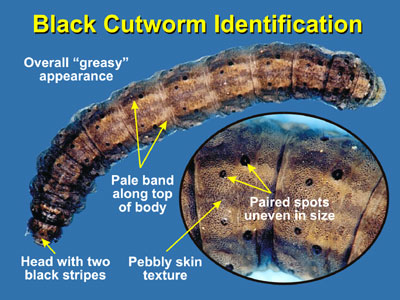General Information
Common name: Cutworm
Scientific name:
Spodoptera litura, S. littoralis, S. frugiperda, S. eridania
Lepidoptera:Noctuidae
Synonyms: Cotton leaf armyworm, Climbing worm, Common cutworm, Tobacco caterpillar
Host plants
Cotton, crucifers, cucurbits, solanaceous, groundnut, maize, sweet potatoes, rice, wheat, legumes, onions
Distribution
Africa, Australia, Pacific Islands, southern Europe, Asia
Damage
Seedlings are often cut off at ground level. Cutworm larvae can be found in the soil (up to a depth of about 5 cm) near the plant host. They always curl-up when disturbed. Cutworms feed only at night. Generally, they are not found on plants or on the soil surface during the day.
n
Young caterpillars eat the soft leaves of the plant. The full grown caterpillars are capable of eating the entire plant. The newly hatched larvae feed from the base towards the tip of the leaf. At this stage, they first feed on the epidermis and may discolor the entire leaf surface.
The yellowing of the leaves is a typical symptom of Spodoptera when they cause damage to thick-leaf plants such as castor. But the larvae can devour the entire leaves of rice and other cereals (Mochida, 1973: pp. 16-24). In beans, larvae will feed on leaves, buds, flowers, and pods. Larger larvae will tunnel into and destroy the bean pod and seeds. In corn, larvae will feed on leaves, silk, and ears.
Description
Eggs are tiny pearl white, round, and have a ridged surface.
The newly hatched Spodoptera larvae are greenish and about 1 mm long. The full-grown larva has a cylindrical body, brown or brownish-black with a tinge of orange. The
thoracic segments have one to two dark spots near the base of the legs. The abdominal segments generally have two light brownish lateral lines on each side, one above and one below the
spiracles. Above the top lines are broken lines composed of velvet semi-crescent patches that vary in color among cutworms.
The pupa is black or brown in color and measures about 22.5 mm long and 9.2 mm wide.
The adult has dark brown forewings with distinctive black spots and white and yellow wavy stripes. The hind wings are whitish with grayish margins. The total
developmental period from egg to adult is about 35-40 days.
Other cutworm species
Black cutworm (
Agrotis ipsilon)
Eggs are white, ball-shaped, and sculptured with numerous vertical ridges. They are laid in groups of 10-20 eggs. Newly hatched larvae are about 5 mm and nearly 5 cm long when fully grown. Their color ranges from gray to nearly black. The center along the back has a pale rather indistinct narrow stripe. The skin texture distinguishes them from other cutworms. It consists of convex, rounded, coarse granules with smaller granules interspaced in between. The moths are brownish in color with black slashes near the outer edges of the front wings. Adults are similar in size and shape with other cutworm species. There is no distinguishing characteristic to differentiate them from other cutworms.

Photo courtesy of University of Nebraska
(
Peridroma saucia)
Variegated cutworms are dull-colored ranging from 1.5-5 cm in length. Mature larvae are 3.8-5 cm long with a smooth skin. Body color varies from pale gray to dark mottled-brown intermixed with red and yellow dots. There is usually a narrow orange-brown stripe on the sides. This climbing cutworm usually feeds on buds and leaves of plants.
Granulate cutworm (
Feltia subterranean)
Granulate cutworm larva is gray to reddish-brown with dull yellowish sub-dorsal markings on the abdominal segments. The head is yellowish to brownish. The under-surface of the body is flecked with white. It causes its most serious damage by cutting-off small plants near the ground. If the plant is too large to be severed at ground level, the larva climbs the plant and feeds on the foliage.

